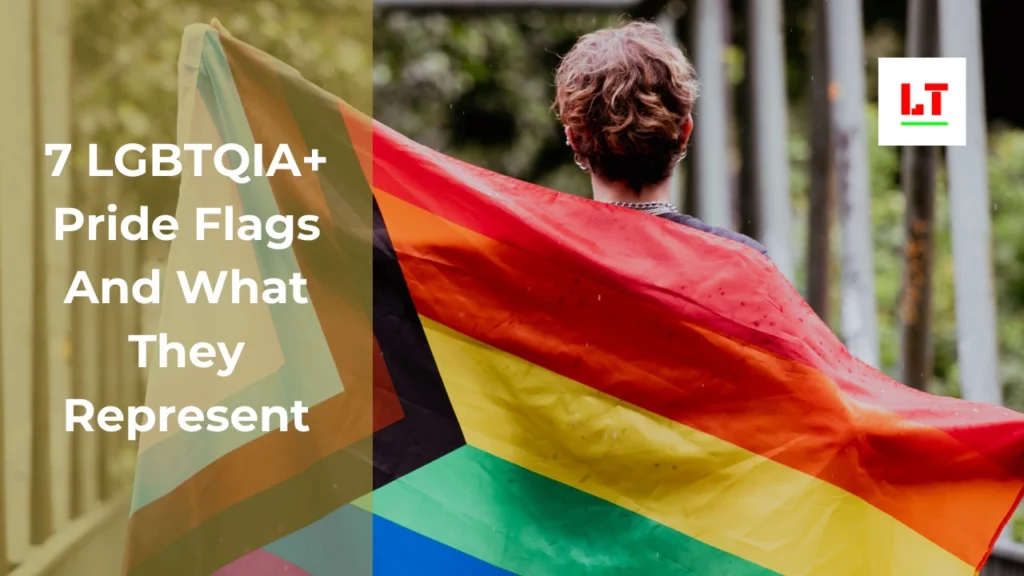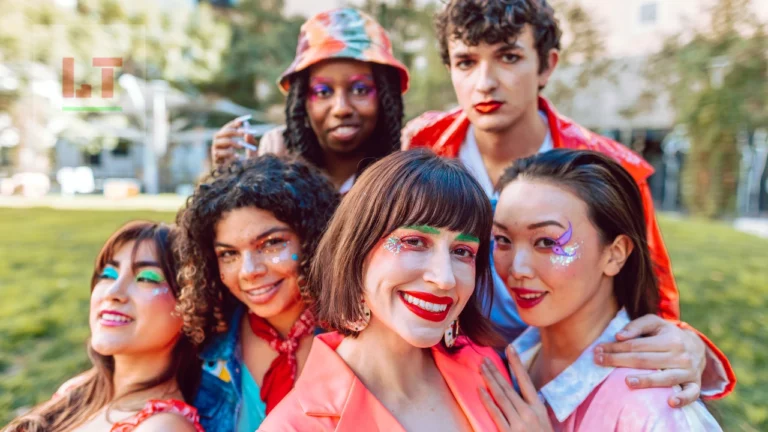We should indeed keep calm in the face of difference, and live our lives in a state of inclusion and wonder at the diversity of humanity.
George Takei
All Types of LGBTQ Flags! The LGBT+ community is diverse and complex, with many different identities, experiences, and cultures represented within it. One way that members of the community express their identity and pride is through the use of flags and other symbols that represent different aspects of the LGBTQ+ experience. Here we will explore 7 LGBTQIA+ Pride Flags.
In this, we will explore the many different types of LGBT+ symbol that exist, including the widely recognized rainbow symbol, as well as symbol that represent specific identities such as transgender, bisexual, and asexual. We’ll also take a look at some of the lesser-known symbol that represent different subcultures within the LGBT+ community, such as the leather and bear communities.
Discussing the history and symbolism behind each flag, as well as their use within the LGBTQ+ community and beyond. Exploring how banners and symbols empower and have meaning to LGBT+ people, and acknowledging their potential for controversy or divisiveness.
Whether you’re a member of the LGBTQ+ community or an ally, we hope this will provide you with a deeper understanding and appreciation of the many different ways in which people express their identity and pride. Let’s dive in!
7 LGBTQIA+ Pride Flags & what they represent?
1. Rainbow Flag:
The rainbow flag is the most widely recognized symbol of the LGBTQ+ community. It is a multicolored flag featuring stripes of red, orange, yellow, green, blue, and purple. The flag originated in 1978 when artist and activist Gilbert Baker, at the request of Harvey Milk, one of the first openly gay elected officials in the United States, designed it as a symbol of pride for the gay community.
The colors of the rainbow symbol have specific meanings. Red represents life, orange represents healing, yellow represents sunlight, green represents nature, blue represents harmony and peace, and purple represents spirit. The flag symbolizes the diversity and unity of the LGBT+ community and represents the ongoing struggle for equal rights and acceptance.
Also Read – 10 LGBTQ Flags (Pride Flags) and what do they stand for?
Since its creation, the rainbow banner has become an iconic symbol of LGBT+ pride and visibility. People fly it at pride events globally, as well as in public spaces and private homes, as a gesture of support for the LGBT+ community.
The flag has undergone various adaptations and modifications to represent distinct identities and subcultures within the LGBT+ community, including symbols for transgender, bisexual, and asexual pride.
However, the rainbow symbol has also been the subject of controversy and criticism within the LGBT+ community. Some have argued that the symbol is not inclusive enough of people of colour, or of marginalized groups within the LGBT+ community such as bisexual or transgender individuals.
Critics have raised concerns about the symbol’s commercialization, commodification, and its appropriation by corporations and mainstream culture.
Despite these debates, the rainbow flag remains an important symbol of LGBT+ pride and visibility, and a powerful reminder of the on-going struggle for equality and acceptance.
2. Transgender Flag:
The transgender flag is a symbol of the transgender community and was created by Monica Helms, a transgender woman, in 1999. The symbol features stripes of light blue, pink, and white, and has become an important symbol of transgender pride and visibility.
The colours of the transgender symbol have specific meanings. The light blue stripe symbolizes the traditional color for baby boys and signifies the male identity often assigned to transgender individuals at birth.
The pink stripe symbolizes the traditional color for baby girls and signifies the female identity often assigned to transgender individuals at birth.Also, The white stripe represents those who are intersex, transitioning, or identifying as gender-neutral.
The transgender banner was crafted to offer a symbol of pride and visibility for the transgender community, which previously lacked a widely recognized symbol. Since its creation, the transgender symbol has become an important symbol of the struggle for transgender rights and acceptance.
Also Read – 77 LGBTQ+ Pride Gift Ideas for Pride month
Leader’s Tip:
In order to empower LGBTQIA+ people in the workplace, embrace sincerity.

In addition to the transgender flag, there are other flags that represent different aspects of the transgender experience. For example, the non-binary flag, which features stripes of yellow, white, purple, and black, represents people who identify outside of the gender binary. The genderfluid flag, which features stripes of pink, white, purple, black, and blue, represents people whose gender identity varies over time.
The transgender flag and other flags representing transgender identities are important symbols of visibility and empowerment for the transgender community. They serve to raise awareness about the diversity of gender identities and experiences, and to promote acceptance and equality for all transgender individuals.
3. Bisexual Flag
The bisexual flag is a symbol of the bisexual community and was created in 1998 by Michael Page. The flag features three horizontal stripes of pink, purple, and blue.
The colors of the bisexual symbol have specific meanings. The pink stripe represents attraction to the same gender, the blue stripe represents attraction to the opposite gender, and the purple stripe represents attraction to both genders.
The bisexual banner was created to provide a symbol of pride and visibility for the bisexual community, which had previously lacked a widely recognized symbol. Bisexual individuals often face discrimination and erasure, both within the LGBT+ community and in broader society. The flag serves as a powerful reminder of the existence and importance of bisexual identities and experiences.
In addition to the bisexual flag, there are other symbol that represent different aspects of the bisexual experience. For instance, the pansexual symbol, characterized by stripes in pink, yellow, and blue, represents individuals attracted to all genders, not just two.
The omnisexual symbol, characterized by stripes in pink, orange, and yellow, represents individuals attracted to all genders but with a preference for one gender.
The bisexual symbol and other symbol representing bisexual identities are important symbols of visibility and empowerment for the bisexual community. They serve to raise awareness about the diversity of sexual orientations and experiences, and to promote acceptance and equality for all bisexual individuals.
Handpicked for you: Quality Transformation in VUCA
4. Pansexual Flag
The pansexual flag is a symbol of the pansexual community and was created by Jasper Wilde in 2010. The flag features three horizontal stripes of pink, yellow, and blue.
The colors of the pansexual symbol have specific meanings. The pink stripe represents attraction to those who identify as female, the blue stripe represents attraction to those who identify as male, and the yellow stripe represents attraction to those who identify as non-binary or gender-queer, as well as those who identify as any other gender or no gender at all.
The pansexual banner was crafted to provide a symbol of pride and visibility for the pansexual community, which previously lacked a widely recognized symbol. Pansexual individuals experience attraction irrespective of gender identity and often encounter erasure and misunderstanding from both the LGBTQ+ community and society at large.. Also, The symbol serves as a powerful reminder of the existence and importance of pansexual identities and experiences.
Also Read – The Best Walking shoes for Maximum Comfort
In addition to the pansexual flag, there are other symbol that represent different aspects of the pansexual experience. For example, the demisexual symbol, which features stripes of purple, gray, white, and black, represents people who only experience sexual attraction after forming a strong emotional connection with someone.
The asexual spectrum symbol, which features stripes of black, gray, white, and purple, represents people who experience little or no sexual attraction
5. Non-binary Flag
The non-binary banner is a symbol of the non-binary community and was designed by Kye Rowan in 2014. The flag features stripes of yellow, white, purple, and black.
The colors of the non-binary symbol have specific meanings. The yellow stripe represents people who identify outside of the gender binary, the white stripe represents people with multiple genders, the purple stripe represents those who identify as a mixture of male and female, or as neither male nor female, and the black stripe represents people who are a-gender, meaning they do not identify with any gender.
The non-binary banner was designed to provide a symbol of pride and visibility for the non-binary community, including those identifying as gender-fluid, gender-queer, or other non-binary identities.
Non-binary individuals often face discrimination and erasure, both within the LGBT+ community and in broader society. The flag serves as a powerful reminder of the existence and importance of non-binary identities and experiences.
In addition to the non-binary symbol, there are other symbol that represent different aspects of the non-binary experience. For example, the gender-fluid symbol, which features stripes of pink, white, purple, black, and blue, represents people whose gender identity varies over time.
The gender-queer flag, which features stripes of lavender, white, and chartreuse, represents people whose gender identity is outside of the traditional binary of male and female.
Also Read – A Good Leader Is A Good Follower
Leader’s Tip
Promote inclusive policies and give voice to and support the experiences of LGBTQIA+ people.
6. Genderfluid Flag
The gender-fluid banner is a symbol of the gender-fluid community and was designed by JJ Poole in 2012. The symbol features five horizontal stripes of pink, white, purple, black, and blue.
The colors of the gender-fluid symbol have specific meanings. The pink stripe represents femininity, the white stripe represents neutrality or lack of gender, the purple stripe represents a combination of masculinity and femininity, the black stripe represents all other genders, and the blue stripe represents masculinity.
The gender-fluid symbol was crafted to provide a symbol of pride and visibility for the genderfluid community, embracing individuals whose gender identity changes over time. Genderfluid individuals often face erasure and misunderstanding from both the LGBT+ community and wider society.Thus, the symbol serves as a powerful reminder of the existence and importance of genderfluid identities and experiences.
In addition to the genderfluid banner, there are other symbol that represent different aspects of gender identity and expression. For example, the transgender symbol, featuring stripes of light blue, pink, and white,
The non-binary symbol, which features stripes of yellow, white, purple, and black, represents people who identify outside of the gender binary.
7. Intersex Flag
The intersex banner, created by intersex activist Morgan Carpenter in 2013, symbolizes the intersex community.The symbol features a yellow circle on a purple background.
The colors of the intersex symbol have specific meanings. The circle represents unbroken and unornamented wholeness, while the yellow color symbolizes a bright and sunny future, free from shame and secrecy.
The purple background represents the overlap between the typical male (blue) and female (pink) gendered colors, reflecting the fact that intersex people have a variety of biological sex characteristics that do not fit typical male or female categories.
Also Read – The Best Leadership Skills For Startup Leaders
Check this video out:
FAQs
What are the colours of the LGBT flag?
One of the most well-known and frequently used LGBT flags in history is the 6-Color Pride Flag. Red, orange, yellow, green, indigo, and violet are all present on this flag.
What do the colours on the rainbow flag represent?
The colours on the rainbow flag each have their own symbolic meaning. Here is one interpretation of the meanings of the colours:
Red: Life
Orange: Healing
Yellow: Sunlight
Green: Nature
Blue: Harmony/Peace
Purple: Spirit
What pride flag has 5 stripes?
The gender-fluid banner is a symbol of the gender-fluid community and was designed by JJ Poole in 2012. The symbol features five horizontal stripes of pink, white, purple, black, and blue.
Key Takeaways
- Pride flags symbolize various LGBTQIA+ identities, promoting visibility and acceptance.
- Understanding their meanings promotes empathy, respect, and community cohesion, according to statement.
- By raising these flags, we reaffirm our commitment to diversity and equality.

